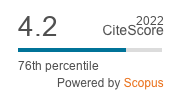Climate change and water resources in Ireland : initial investigation using downscaled GCMS and hydrological modelling techniques
DOI:
https://doi.org/10.18172/cig.1118Abstract
Predictions are made of changes in effective runoff at a high spatial resolution for the island of Ireland under different climate change scenarios. Although previous studies have examined the response of selected Irish catchments to future climate scenarios this is the first time that the whole area of the island has been considered. This paper discusses the initial investigation that has been carried out and outlines research currently in progress. Polynomial regression techniques are used to derive a baseline climatology for Ireland. Downscaled precipitation and evaporation data from the United Kingdom Climate Program (UKCIP) for the Medium-low 2080 scenario is used together with the baseline data for the initial investigation. The precipitation and potential evaporation (PE) data are converted to a suitable form for input to HYSIM. Two sets of simulations are carried out for 825 10 x 10 km grid squares covering the land area of the island of Ireland for the baseline period and the 2080 scenario. The hydrological parameters for each of these squares are considered to be identical for this initial investigation. The results of this investigation are presented. Future work is considered, focusing on the parameterisation of HYSIM for individual grid cells. The initial investigation demonstrates that the representation of storage is of particular importance. Parameter values are derived for each square using data from the Soil Survey of Ireland, the CORINE land use database and information on major aquifers provided by the Geological Survey of Ireland. The flexible data requirements of HYSIM allow some representation of the diverse hydrological conditions found within Ireland. For example, approximately 40% of Ireland is underlain by limestones, many of which are karstified. These karst aquifers are an important water resource and can respond very rapidly to precipitation inputs. There are also extensive areas of lakes and wetlands. The land area is divided into broad hydrological zones to provide some representation of this variabilityDownloads
Download data is not yet available.
Downloads
Published
28-05-2013
How to Cite
1.
Charlton R, Moore S, Sweeney J, Fealy R. Climate change and water resources in Ireland : initial investigation using downscaled GCMS and hydrological modelling techniques. CIG [Internet]. 2013 May 28 [cited 2024 Apr. 19];27:125-3. Available from: https://publicaciones.unirioja.es/ojs/index.php/cig/article/view/1118
Issue
Section
Articles
License
The authors retain copyright of articles and authorize Cuadernos de Investigación Geográfica / Geographical Research Letters the first publication. They are free to share and redistribute the article without obtaining permission from the publisher as long as they give appropriate credit to the editor and the journal.
Self-archiving is allowed too. In fact, it is recommendable to deposit a PDF version of the paper in academic and/or institutional repositories.
It is recommended to include the DOI number.
This journal is licensed under a Creative Commons Attribution 4.0 International License











